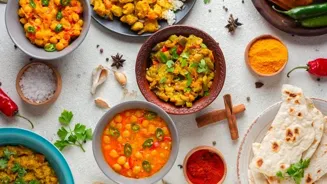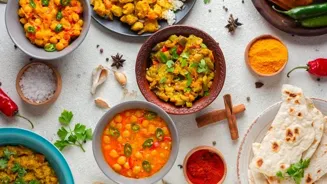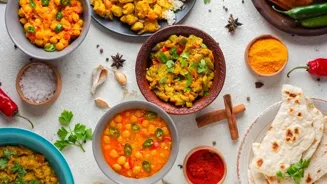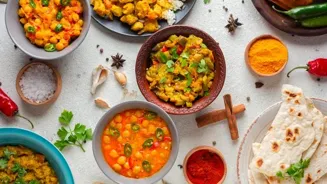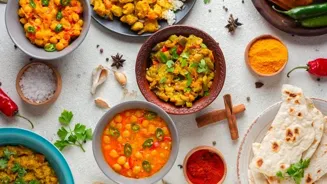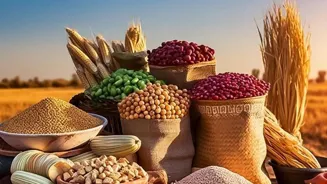Unveiling the Legacy of Indian Flatbreads: Explore the journey from Roti to Paratha and beyond! Discover the culinary evolution of these staple delights
India, a land of diverse cultures and traditions,
boasts a culinary heritage as rich and varied as its people. At the heart of Indian cuisine lies the humble yet indispensable flatbread.
From the simple roti to the layered paratha, these unleavened breads have been a staple in Indian diets for centuries, evolving alongside its history and culture.
The story of Indian flatbreads is a captivating journey through time, reflecting the country's agricultural practices, culinary innovations, and regional variations.
Flatbreads require skill despite simple appearance
These flatbreads have a simplicity that belies the culinary expertise required to make them.
Origins of Indian flatbreads from Indus Valley Civilization
The origins of Indian flatbreads can be traced back to the Indus Valley Civilization, one of the world's earliest urban societies, flourishing around 2500 BCE. Archaeological evidence suggests that wheat and barley were cultivated in this region, forming the basis of their diet.
Early forms of unleavened bread, likely cooked on hot stones or rudimentary tavas (griddles), were probably the precursors to modern-day roti. The term "roti" itself is derived from the Sanskrit word "rottika," meaning bread.
While the exact methods of preparing these early breads remain a mystery, it's clear that they were an essential part of the Indus Valley diet. The flatbread traditions likely were passed on through generations, carried through migrations across the landscape.
As civilizations evolved, flatbreads remained relevant. In recent years, there has been a rediscovery of techniques.
Indo-Aryan migration shaped Indian flatbread evolution, varied by region
As the Indo-Aryan people migrated into the Indian subcontinent, they brought with them their agricultural practices and culinary traditions, further shaping the evolution of Indian flatbreads. Wheat cultivation spread across the northern plains, becoming a staple crop.
The Vedic texts mention "apupa," a type of cake made from grain flour, which may have been an early form of flatbread. Over time, variations in ingredients and cooking methods led to the development of different types of flatbreads, each adapted to the local climate, ingredients, and tastes.
These advancements in flatbread making has increased its reach and accessibility across various cultures. The tradition of making fresh flatbreads is still followed across modern households. These flatbreads are used to complement Indian gravies and curries.
Mughal era elevates Indian cuisine with parathas and naan
The Mughal era, beginning in the 16th century, brought significant influences to Indian cuisine, including the introduction of new ingredients and cooking techniques. The Mughals, known for their refined tastes and elaborate culinary traditions, elevated the humble flatbread to new heights.
It was during this period that the paratha, a layered and often stuffed flatbread, gained prominence. The Mughals introduced the use of ghee (clarified butter) and rich fillings, transforming the simple roti into a delectable treat.
The influence of the Mughals is evident in the names of various paratha dishes, such as "Mughlai paratha," which is often stuffed with eggs and spices ( a vegeterian variant is there too).
This era also saw the rise of other flatbread variations, such as naan, baked in tandoors (clay ovens), becoming a popular accompaniment to Mughal dishes. The Mughals transformed the world of the flatbreads.
Regional diversity in Indian cuisine through varied flatbreads
Regional diversity is a hallmark of Indian cuisine, and this is reflected in the vast array of flatbreads found across the country. In North India, roti, paratha, and naan are staples, often served with vegetable curries and dals (lentil soups).
In South India, dosas (thin, crispy pancakes made from fermented rice and lentil batter) and uttapams (thick pancakes topped with vegetables) are popular choices. In Western India, bhakri (a coarse flatbread made from millet or sorghum flour) is a common accompaniment to meals.
Each region boasts its unique flatbread variations, reflecting the local ingredients, climate, and culinary traditions. For example, in Rajasthan, bajra roti (made from pearl millet) is a hearty and nutritious staple, while in Maharashtra, thalipeeth (a multi-grain pancake) is a popular snack.
These diverse flatbreads add flavor and texture to the regional cuisines of India, making them an integral part of the country's culinary identity. Flatbreads can be enjoyed with sides like chutney and yogurt.
Indian flatbread-making: communal tradition preserving culinary heritage
The preparation of Indian flatbreads is often a communal activity, passed down through generations. In many Indian households, making roti is a daily ritual, with family members coming together to knead the dough, roll out the breads, and cook them on the tava.
The process is not just about preparing food; it's also a way of bonding and sharing traditions. The skills and techniques for making perfect roti or paratha are often learned from mothers and grandmothers, ensuring that these culinary traditions are preserved.
The act of sharing freshly made flatbreads with family and friends is an expression of love and hospitality, reflecting the importance of food in Indian culture. These traditions are meant to be continued for generations. These shared traditions are extremely important.
Indian flatbreads: evolving with tradition and innovation worldwide
Today, Indian flatbreads continue to be a staple in diets across India and around the world. With the growing popularity of Indian cuisine, roti, paratha, naan, and dosa are now found in restaurants and homes across the globe. Innovation continues to be a part of the evolution of flatbread.
Modern innovations, such as pre-made dough and electric roti makers, have made the preparation of flatbreads more convenient. However, the traditional methods of making flatbreads by hand are still widely practiced, preserving the authenticity and flavor that have been cherished for centuries.
As Indian cuisine continues to evolve, flatbreads will undoubtedly remain an integral part of its culinary landscape, adapting to new tastes and trends while retaining their rich history and cultural significance. The traditional methods continue to be very popular till date.
These flatbreads are rich in carbs and provide energy.
AI Generated Content. Glance/InMobi shall have no liability for the content